Space-Based Passive Orbital Maneuver Detection Algorithm for High-Altitude Situational Awareness
Abstract
:1. Introduction
2. Problem Statement
2.1. Framework of the Maneuver Detection Algorithm Based on Angles-Only Measurements
2.2. Relative Motion Dynamics Model
2.3. Measurement Model
3. Modeling of the Maneuvering Characterization and Its Sensitivity Analysis
3.1. Concept of Relative Angular Momentum
3.2. Sensitivity Analysis
4. Maneuver Detection Algorithm
5. Numerical Simulations
5.1. Error Models
5.2. Reference Mission and Trajectory
5.3. Computation Models for Estimation of the Error
6. Performance Analysis
6.1. Settings of Key Parameters
6.2. Results of Long-Range Cases
6.2.1. Advantage of the Relative Angular Momentum
6.2.2. Maneuver Detection Error and the True Positive Rate
6.2.3. Double Single-Impulse Maneuver Detection and Tracking
6.3. Results of Close-Range Cases
7. Conclusions
Author Contributions
Funding
Data Availability Statement
Conflicts of Interest
References
- Mark, C.P.; Kamath, S. Review of active space debris removal methods. Space Policy 2019, 47, 194–206. [Google Scholar] [CrossRef]
- Hakima, H.; Bazzocchi, M.; Emami, M.R. A deorbiter CubeSat for active orbital debris removal. Adv. Space Res. 2018, 61, 2377–2392. [Google Scholar] [CrossRef]
- Hakima, H.; Emami, M.R. Assessment of active methods for removal of LEO debris. Acta Astronaut. 2018, 144, 225–243. [Google Scholar] [CrossRef]
- Surdi, S.A. Space situational awareness through blockchain technology. J. Space Saf. Eng. 2020, 7, 295–301. [Google Scholar] [CrossRef]
- Chen, Y.T.; Tian, G.Q.; Guo, J.Y.; Huang, J. Task planning for multiple-satellite space- situational-awareness systems. Aerospace 2021, 8, 73. [Google Scholar] [CrossRef]
- Miller, G.D. Deterrence by Debris: The Downside to Cleaning up Space. Space Policy 2021, 58, 101447. [Google Scholar] [CrossRef]
- Serfontein, Z.; Kingston, J.; Hobbs, S.; Holbrough, I.E.; Beck, J.C. Drag augmentation systems for space debris mitigation. Acta Astronaut. 2021, 188, 278–288. [Google Scholar] [CrossRef]
- Xu, W.D. Space Competition and Cooperation: Current Space Security and Chinese Responsive Approaches. Space Debris Res. 2021, 21, 18–25. [Google Scholar]
- Zhang, S.J.; Duan, C.Y.; Su, H. Natural-artificial Space Security Threats and Their Mitigation Strategies. J. Command Control 2015, 1, 92–98. [Google Scholar]
- Sajjad, N.; Mirshams, M.; Hein, A.M. Spaceborne and ground-based sensor collaboration: Advancing resident space objects’ orbit determination for space sustainability. Astrodynamics 2024, 1, 1–23. [Google Scholar] [CrossRef]
- Long, K.; Zhu, Q.C.; Chen, X.; Ma, N. Invited Paper: Trump administration’s Defense Space Strategy adjustment: Motivations, characteristics and implications. Natl. Def. Technol. 2021, 42, 76–84. [Google Scholar]
- Tasif, T.H.; Hippelheuser, J.E.; Elgohary, T.A. Analytic continuation extended Kalman filter framework for perturbed orbit estimation using a network of space-based observers with angles-only measurements. Astrodynamics 2022, 6, 161–187. [Google Scholar] [CrossRef]
- Hao, Y.N.; Chen, J.; Zhu, B.; Wang, Y.Y. Current situation and trend of ground-based space situational awareness system of U.S. Army. Def. Sci. Technol. Ind. 2019, 225, 32–35. [Google Scholar]
- Cui, H.Z.; Liu, W.L.; Tang, G.S.; Song, B.Y.; Ge, M.R. Different thrust maneuvers detection of uncooperative space objects. J. Astronaut. 2016, 37, 253–261. [Google Scholar]
- Liu, Y.; Zhao, H.; Liu, C.; Cao, J.; Wang, J. Maneuver detection and tracking of a space target based on a joint filter model. Asian J. Control 2020, 23, 1441–1453. [Google Scholar]
- Yang, Z.; Li, Z. Research the status of space based optical imaging observation for resident space objects. Foreign Electron. Meas. Technol. 2015, 34, 58–61+78. [Google Scholar]
- Busch, W.F. Enhancing SSA capabilities to ensure the security of all space systems: The French approach. In Proceedings of the 3th Military Space Situational Awareness Conference, London, UK, 25–26 April 2018. [Google Scholar]
- Song, B. Development of U.S. Space-based Space Situational Awareness System. Space Int. 2015, 12, 13–20. [Google Scholar]
- Gong, J.G.; Ning, Y.; Lyu, N. Development and Enlightenment of Space Based Situational Awareness Technology for High Orbit in the United States. Aerosp. Control Appl. 2021, 47, 1–7. [Google Scholar]
- Fan, Z.H.; Cai, Y.X.; Li, F.Z. Study on Development of American Space-based Situational Awareness Technology for GEO Objects. Spacecr. Eng. 2019, 28, 87–95. [Google Scholar]
- Gong, B.C.; Li, W.D.; Li, S.; Ma, W.H.; Zheng, L.L. Angles-only initial relative orbit determination algorithm for non-cooperative spacecraft proximity operations. Astrodynamics 2018, 2, 217–231. [Google Scholar] [CrossRef]
- Liu, Z.X.; Sun, Y.R.; Zeng, Q.H.; Zhao, K.D. Relative Navigation Algorithm Based on DG-IEKF under the Range and Angle Information. Navig. Control 2021, 20, 34–43. [Google Scholar]
- Gong, B.C.; Wang, S.; Li, S.; Li, X. Review of space relative navigation based on angles-only measurements. Astrodynamics 2023, 7, 131–152. [Google Scholar] [CrossRef]
- Du, R.H.; Zhang, X.; Wang, N.; Wang, L.; Zhang, X.X. Research on Autonomous Detection and Tracking Method for Rendezvous and Proximity of an Uncooperative Target. J. Astronaut. 2021, 42, 621–633. [Google Scholar]
- Jia, B.; Blasch, E.; Pham, K.D.; Dan, S.; Chen, G. Space object tracking and maneuver detection via interacting multiple model cubature Kalman filters. In Proceedings of the IEEE Aerospace Conference Proceedings, Big Sky, MT, USA, 7–14 March 2015. [Google Scholar]
- Li, W.F.; Duan, X.J. Detection and Analysis of Orbital Anomalies Based on EMD. In Proceedings of the first China Aerospace Safety Conference, Melbourne, FL, USA, 18–20 May 2015. [Google Scholar]
- Li, Y.; Han, Z.H.; Tian, W. Detecting Orbit Transferring of Geostationary satellites in the EMD Domain Using the adaptive noise threshold. In Proceedings of the 13th Annual Conference on Satellite Communications, Athens, Greece, 13–19 June 2017. [Google Scholar]
- Spurbeck, J.; Jah, M.K.; Kucharski, D.; Bennett, J.C.; Webb, J.G. Near real time satellite event detection, characterization, and operational assessment via the exploitation of remote photoacoustic signatures. J. Astronaut. Sci. 2021, 68, 197–224. [Google Scholar] [CrossRef]
- Huang, P.; Li, H.; Wen, G.; Wang, Z. Application of Adaptive Weighted Strong Tracking Unscented Kalman Filter in Non-Cooperative Maneuvering Target Tracking. Aerospace 2022, 9, 468. [Google Scholar] [CrossRef]
- Yu, S.X.; Wang, X.; Zhu, T.L. Maneuver detection methods for space objects based on dynamical model. Adv. Space Res. 2021, 68, 71–84. [Google Scholar] [CrossRef]
- Yu, D.T.; Wang, H.; You, Y.; Bai, X.Z. A new in-plane maneuver detection method for incomplete orbit information of LEO spacecraft. J. Astronaut. 2013, 34, 314–319. [Google Scholar]
- Huang, J.; Hu, W.D.; Zhang, L.F. Maneuver Detection of Space Object for Space Surveillance. In Proceedings of Esa Special Publication; ESA Special Publication: Noordwijk, The Netherlands, 2013. [Google Scholar]
- Liu, L.; Cao, J.F.; Liu, Y. WFMHT Method of Orbit Maneuver Detection Based on Space-Based Bearing-Only Measurement. J. Northwestern Polytech. Univ. 2018, 36, 1185–1192. [Google Scholar] [CrossRef]
- Wang, Q.R.; Zou, J.W.; Wu, W.Z.; Chen, J. Orbital maneuver detection method of space target based on Neyman-Pearson criterion. Chin. Space Sci. Technol. 2021, 41, 96–103. [Google Scholar]
- Fan, L.H.; Tu, R.; Zhang, R.; Han, J.; Zhang, P.; Wang, S.; Hong, J.; Lu, X. An orbit maneuver detection method based on orbital elements for BeiDou GEO and IGSO satellites. Adv. Space Res. 2022, 69, 3644–3654. [Google Scholar] [CrossRef]
- Qin, Z.W.; Huang, G.W.; Zhang, Q.; Le, W.; Xie, S.; She, H.; Lai, W.; Wang, X. The analysis and detection of orbit maneuvers for the BeiDou satellites based on orbital elements. Acta Geod. Et Geophys. 2021, 56, 501–522. [Google Scholar] [CrossRef]
- Gong, B.C.; Luo, J.J.; Li, S.; Li, W.D. Observability criterion of angles-only navigation for spacecraft proximity operations. Proc. Inst. Mech. Eng. Part G J. Aerosp. Eng. 2018, 233, 4302–4315. [Google Scholar] [CrossRef]
- Yamanaka, K.; Ankersen, F. New state transition matrix for relative motion on an arbitrary elliptical orbit. J. Guid. Control Dyn. 2002, 25, 60–66. [Google Scholar] [CrossRef]
- Roberts, T.G.; Linares, R. Satellite repositioning maneuver detection in geosynchronous orbit using two-line element (TLE) data. In Proceedings of the 71st International Astronautical Congress, Virtual, 12–14 October 2020. [Google Scholar]
- Yahya, N.A.; Varatharajoo, R.; Harithuddin, A.S.M.; Razoumny, Y. Delta-V and ground metric investigations for responsive satellite formation flying. Acta Astronaut. 2022, 193, 20–34. [Google Scholar] [CrossRef]
- Rose, M.E. Elementary Theory of Angular Momentum; Courier Corporation: North Chelmsford, MA, USA, 1995. [Google Scholar]
- Buckland, S.T. Monte Carlo Confidence Intervals. Biometrics 1984, 40, 811–817. [Google Scholar] [CrossRef]


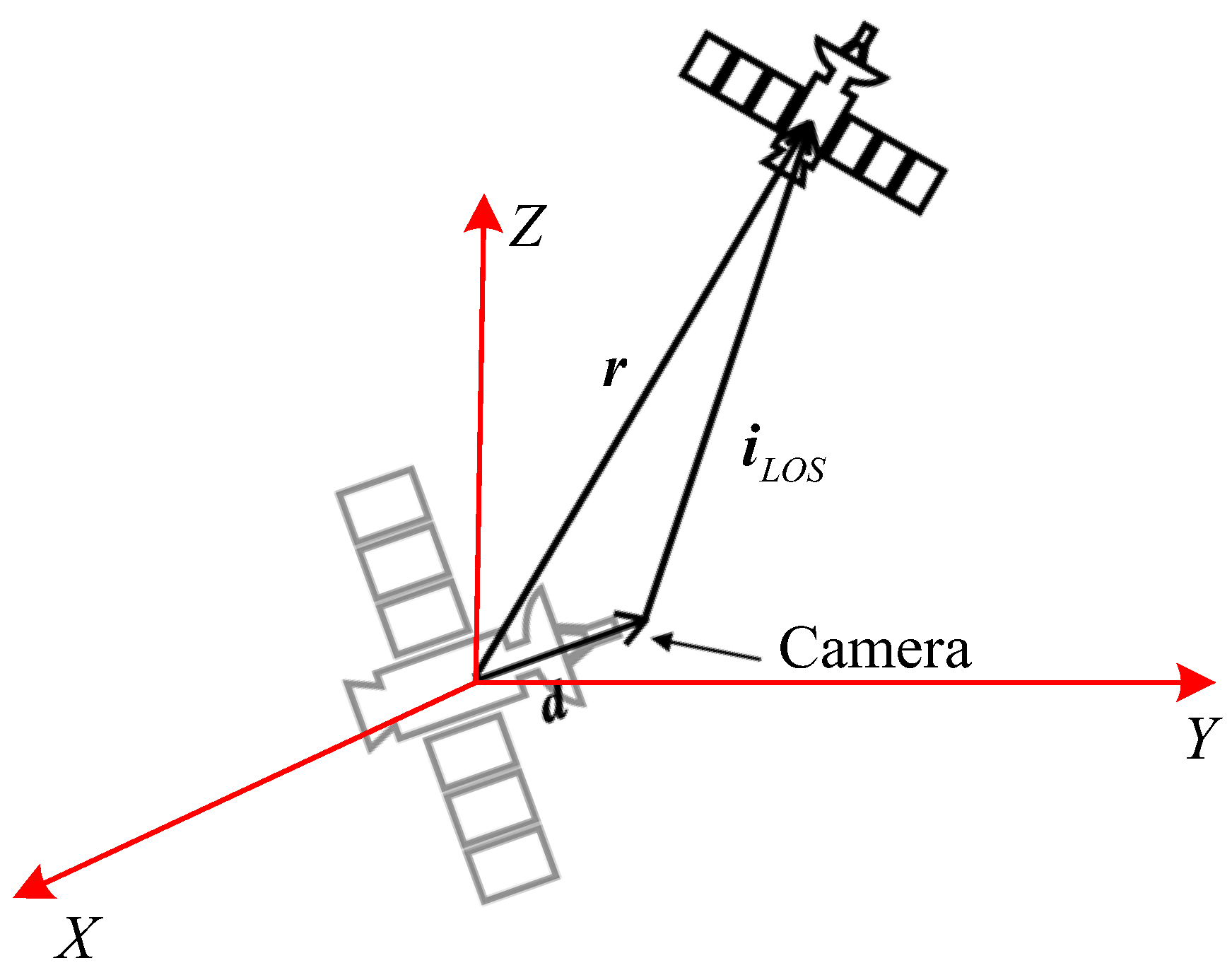

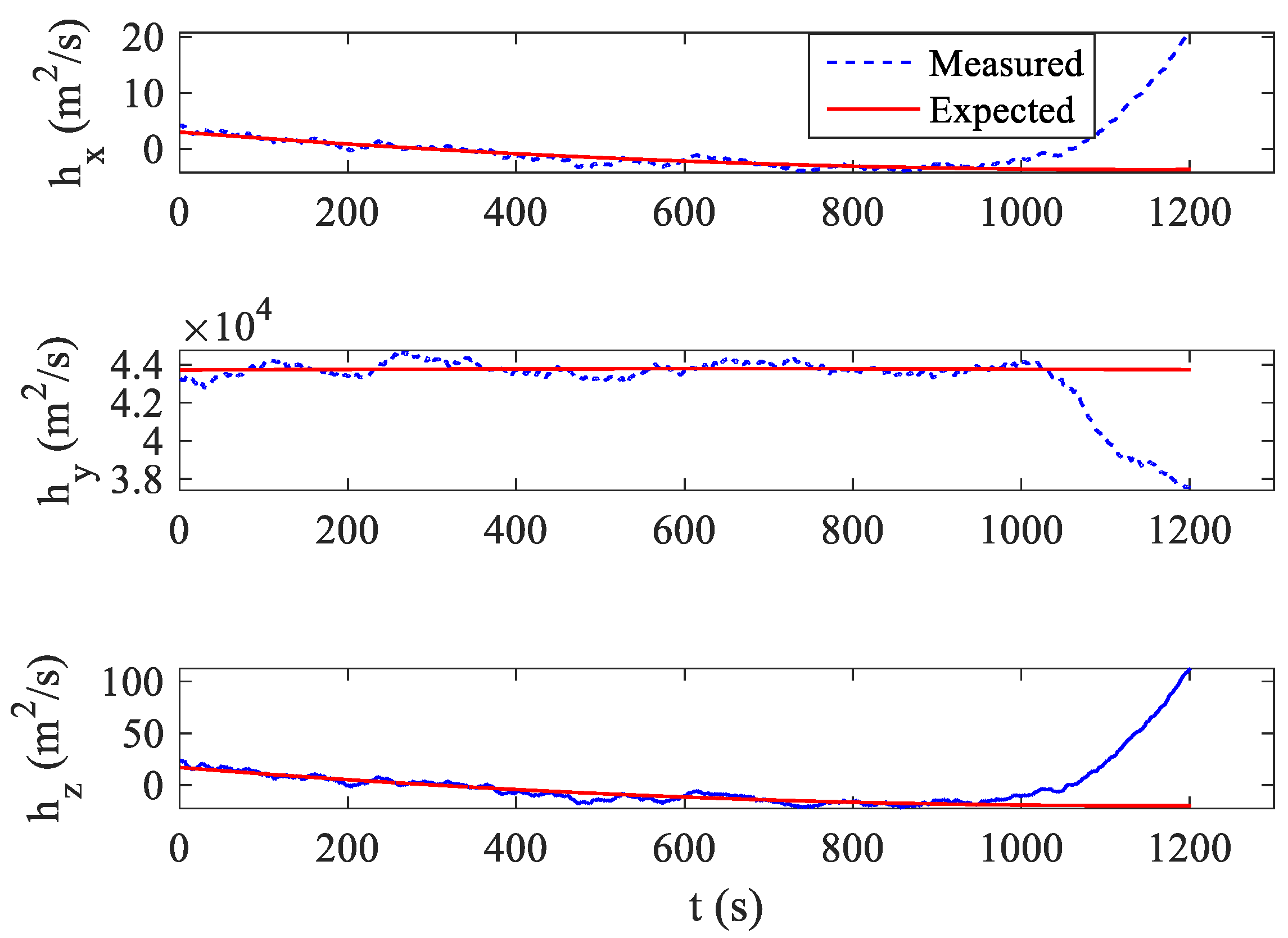


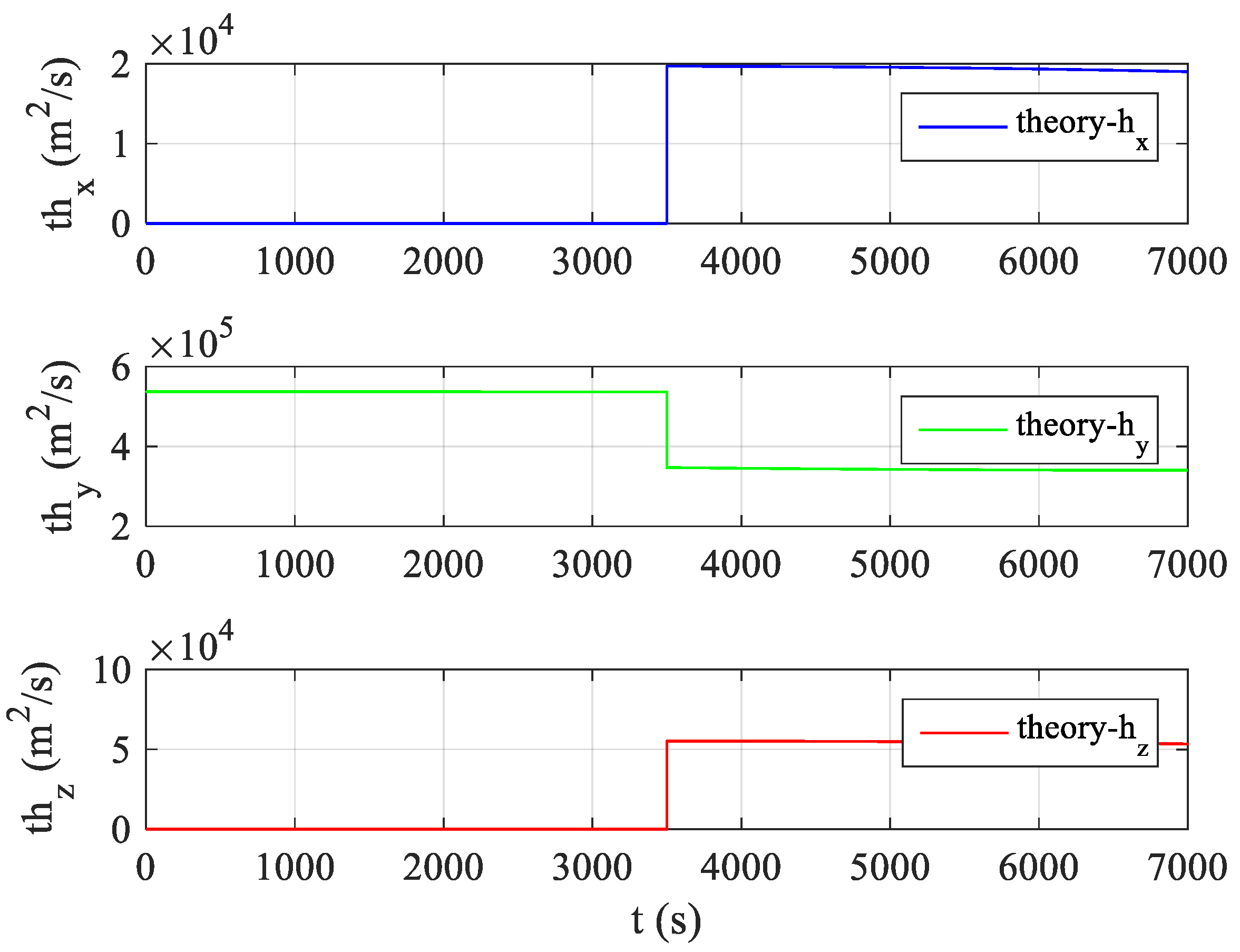

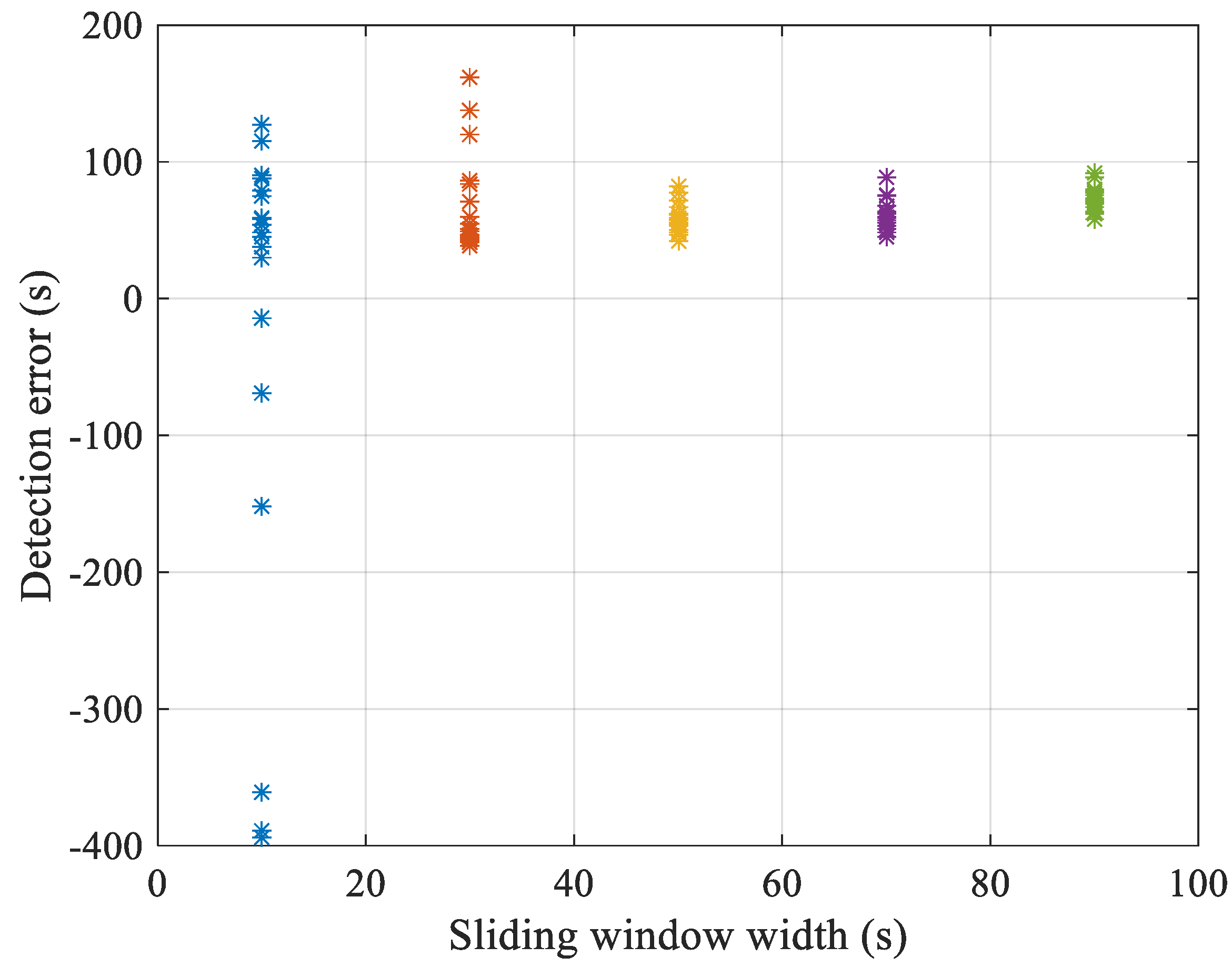
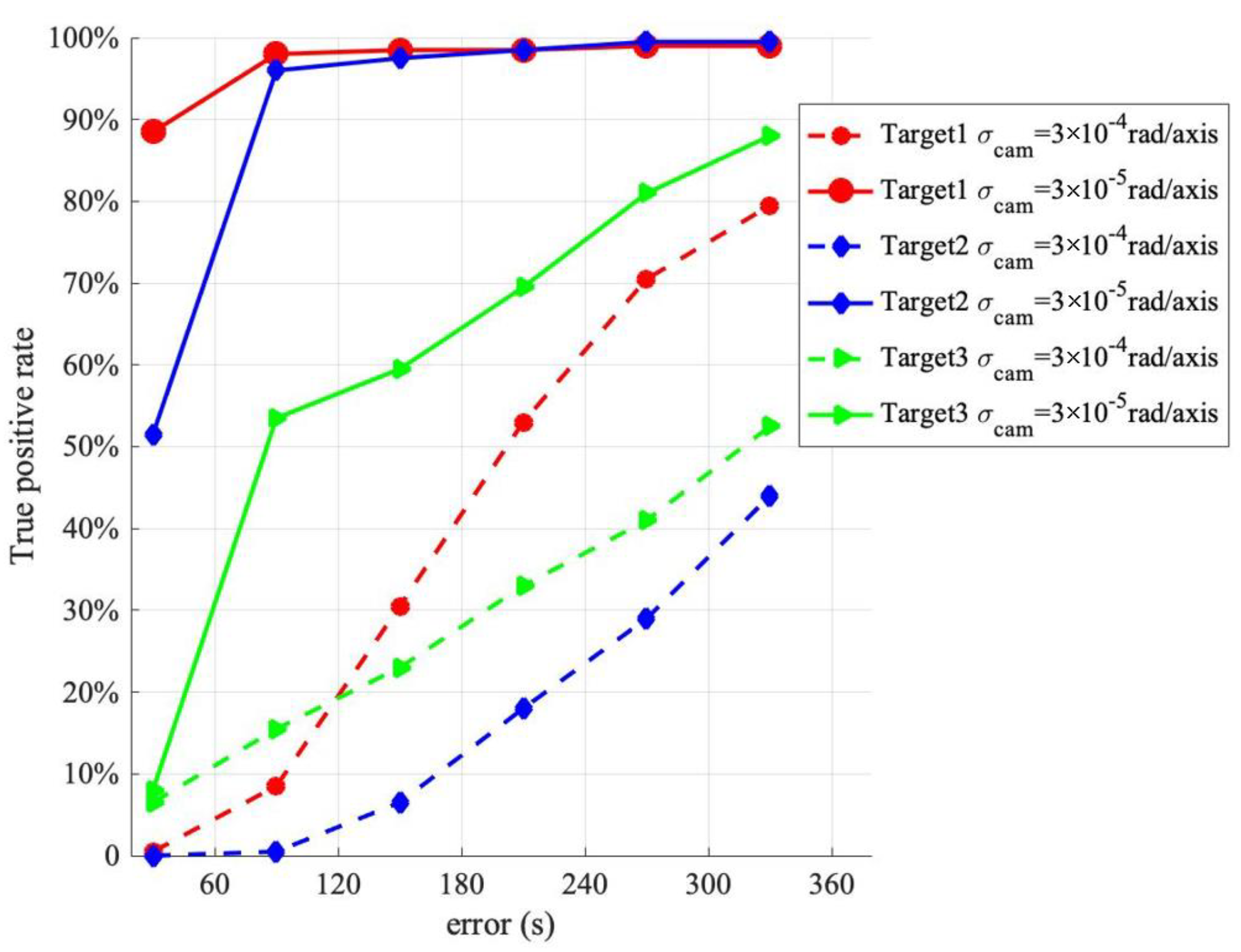

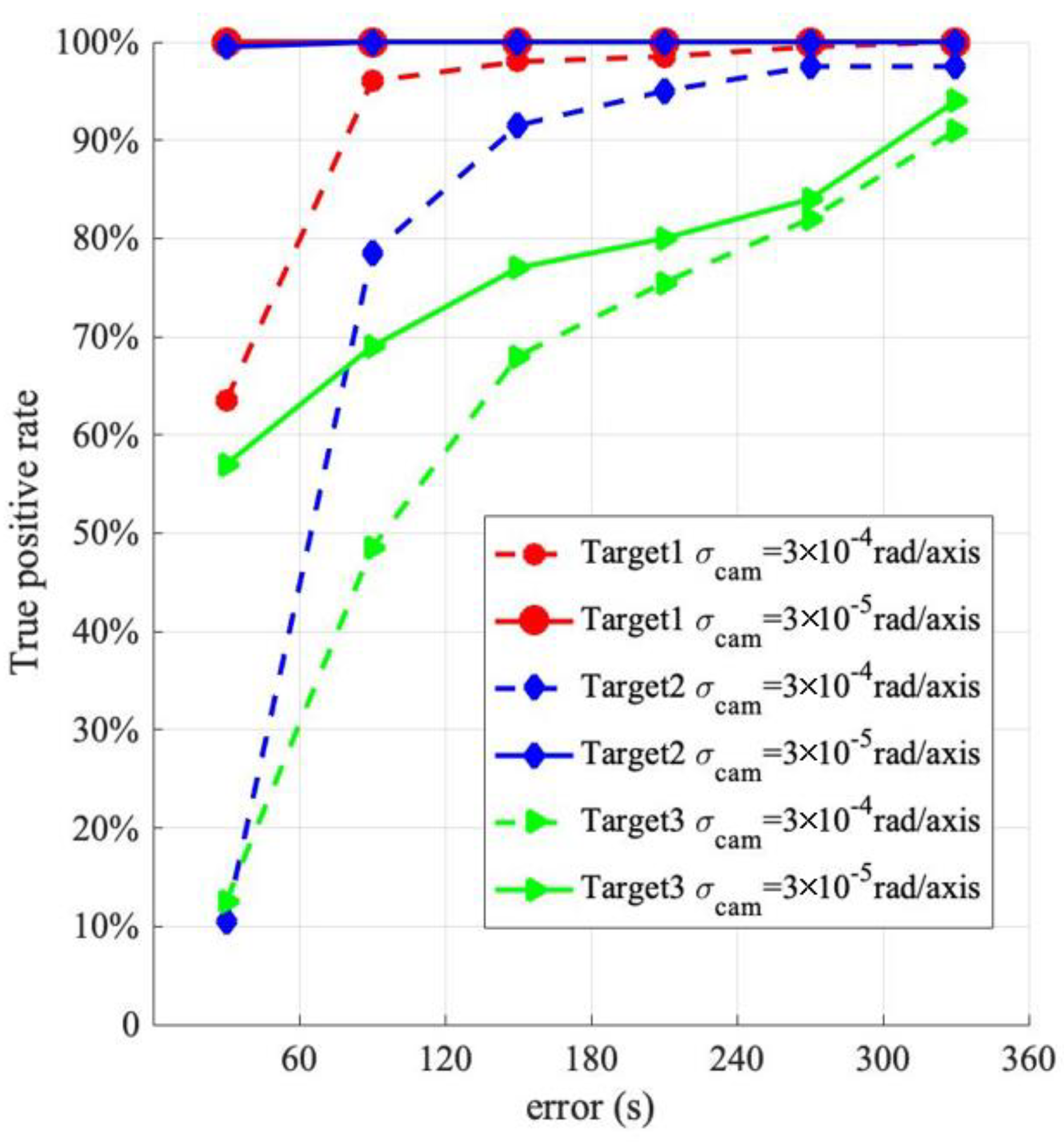

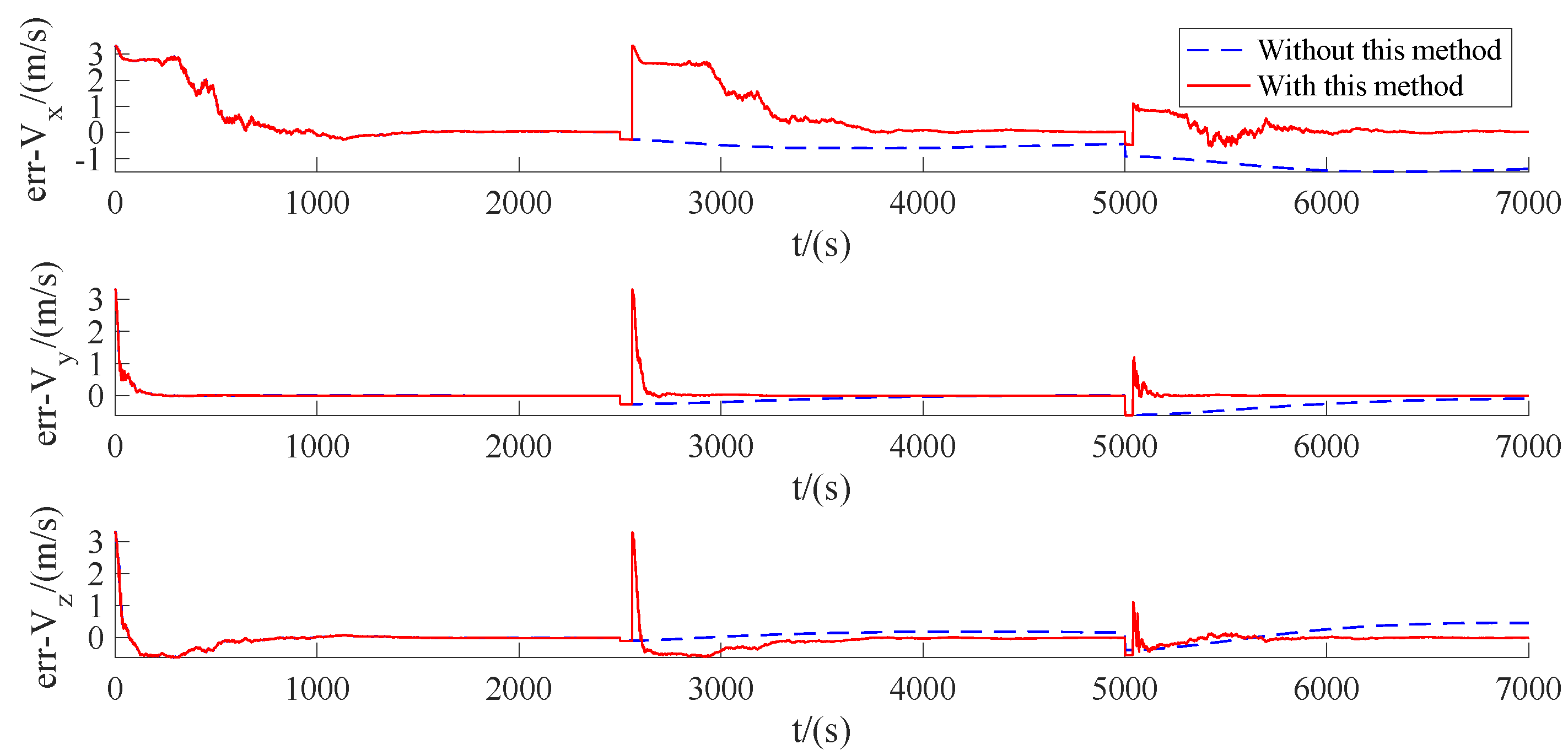
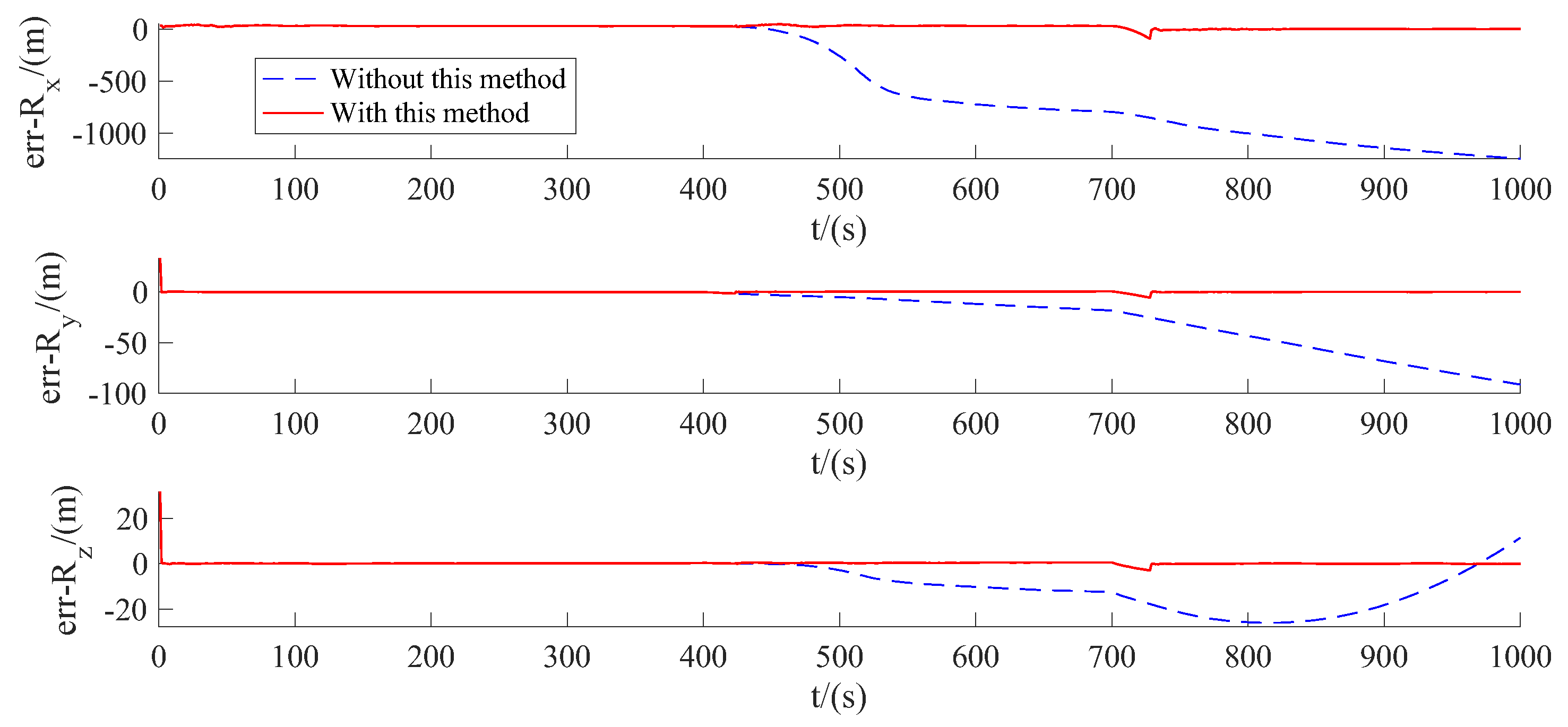

| Semi-Major Axis | Eccentricity | Inclination | Ascending Node | Argument of Perigee | True Anomaly |
|---|---|---|---|---|---|
| 42,278.14 km | 0.001 |
| Altitude Difference | Phase Difference | Inclination Difference | Relative Distance | |
|---|---|---|---|---|
| Target 1 | 20 km | 112.512 km | ||
| Target 2 | 70 km | 232.365 km | ||
| Target 3 | 20 km | 169.431 km |
| Initial Relative Position (m) | Initial Relative Velocity (m/s) | |||||
|---|---|---|---|---|---|---|
| X | Y | Z | X | Y | Z | |
| V-bar Stationary | 1000 | 0 | 0 | 0 | 0 | 0 |
| Co-elliptic Approach | 1000 | 0 | 0 | 0 | 0 | 0.56342 |
| Football Orbit | 1000 | 0 | −100 | −0.16926 | 0 | 0 |
| Oscillating Orbit | 1000 | 0 | 0 | 0 | −0.11284 | 0 |
| Target 1 | % | 0.44501% |
| Target 2 | % | 0.2867% |
| Target 3 | % | 0.2031% |
| Target | ||||
|---|---|---|---|---|
| Target 1 | rad/axis | 238.00 s | 85.90 s | 58.05 s |
| rad/axis | 41.80 s | 36.90 s | 35.45 s | |
| Target 2 | rad/axis | 262.91 s | 148.67 s | 89.85 s |
| rad/axis | 55.05 s | 38.80 s | 37.70 s | |
| Target 3 | rad/axis | 230.23 s | 122.13 s | 160.89 s |
| rad/axis | 129.72 s | 59.10 s | 130.67 s |
| Error < 30 s | Error < 60 s | Error < 90 s | Error < 120 s | |
|---|---|---|---|---|
| 93.5% | 98.5% | 98.5% | 98.5% |
Disclaimer/Publisher’s Note: The statements, opinions and data contained in all publications are solely those of the individual author(s) and contributor(s) and not of MDPI and/or the editor(s). MDPI and/or the editor(s) disclaim responsibility for any injury to people or property resulting from any ideas, methods, instructions or products referred to in the content. |
© 2024 by the authors. Licensee MDPI, Basel, Switzerland. This article is an open access article distributed under the terms and conditions of the Creative Commons Attribution (CC BY) license (https://creativecommons.org/licenses/by/4.0/).
Share and Cite
Yang, S.; Jin, X.; Gong, B.; Han, F. Space-Based Passive Orbital Maneuver Detection Algorithm for High-Altitude Situational Awareness. Aerospace 2024, 11, 563. https://doi.org/10.3390/aerospace11070563
Yang S, Jin X, Gong B, Han F. Space-Based Passive Orbital Maneuver Detection Algorithm for High-Altitude Situational Awareness. Aerospace. 2024; 11(7):563. https://doi.org/10.3390/aerospace11070563
Chicago/Turabian StyleYang, Shihang, Xin Jin, Baichun Gong, and Fei Han. 2024. "Space-Based Passive Orbital Maneuver Detection Algorithm for High-Altitude Situational Awareness" Aerospace 11, no. 7: 563. https://doi.org/10.3390/aerospace11070563
APA StyleYang, S., Jin, X., Gong, B., & Han, F. (2024). Space-Based Passive Orbital Maneuver Detection Algorithm for High-Altitude Situational Awareness. Aerospace, 11(7), 563. https://doi.org/10.3390/aerospace11070563






